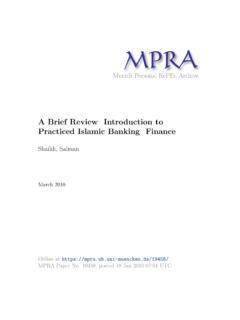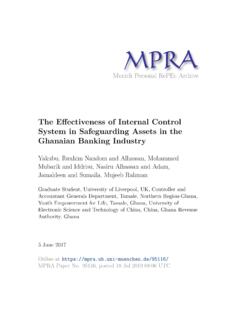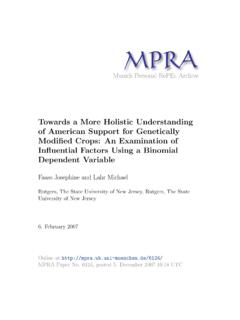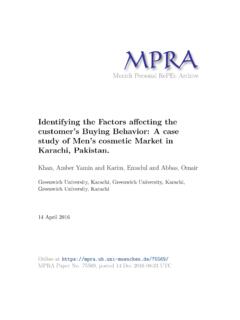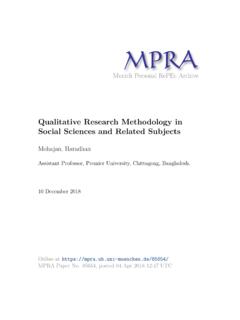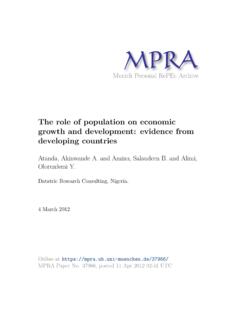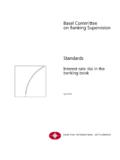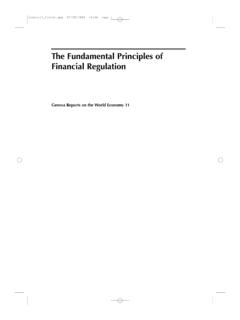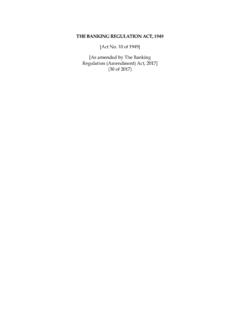Transcription of Risk management process in banking industry - LMU
1 Munich Personal RePEc Archive Risk management process in banking industry Tursoy, Turgut Near East University 30 April 2018. Online at MPRA Paper No. 86427, posted 02 May 2018 14:20 UTC. RISK management process IN banking industry . Turgut T rsoy Abstract This paper covers the latest amendments proposed by the Basel Committee for managing the banking risks through the process of risk management . All the necessary steps in the process are explained in this paper to explain why banks need to have the BIS application to cover any losses from their activities. In summary, as a result of the latest crises, the Basel Committee has developed a new model for covering the shortage of liquidity at the bank level in order to improve their situation to well-performing levels.
2 The main findings in this paper are that as a monetary authority, the support and development of the Basel applications in the banking industry is the most effective option and is a critical necessity for internationally serving banks around the world to continue their activities in a healthy manner. 1. INTRODUCTION. Risk management in banking is theoretically defined as the logical development and execution of a plan to deal with potential losses . Usually, the focus of the risk management practices in the banking industry is to manage an institution's exposure to losses or risk and to protect the value of its assets. In general banking business is regarded as risky business.
3 Economic theory suggests that there are two economic units - surplus unit and deficit unit - and these economic units prefer to use financial institutions (intermediaries) to transfer the necessary funds to each other. Certainly, this process increases the importance of the financial intermediaries in the economy, but also poses some risks to these institutions. Economic units 1. usually prefer to use intermediaries because of the problems associated with asymmetric information. In order to solve the asymmetric information problems, institutions are recruiting skilled employees and systems, that is why the scarce sources of funds are now used more effectively by units in the economy.
4 Therefore, the funds are channelled to the most valuable projects that are beneficial to the economy. However, this process of channelling funds from one unit to another naturally has some inherent risks within the process . Banks are usually managing those risks are part of their normal operations. The risk management process in banking raises various questions. These issues highlight the importance of having risk management practices in banking . These matters are: What kind of events can damage banking business and how much damage can be done? . This question highlights the importance of investigating the activities of the banks that are creating risk or losses and also assessing the potential damage that those risks could cause.
5 Therefore, it can be said that the risk management process starts with the identification of the potential losses or risk and continues by assessing or measuring those issues. What kind of actions should be taken by the institutions in order to manage those risks ? . After identifying and analysing the risk, it is necessary to determine what kind of actions/activities can be implemented by the banks to address these potential hazards. Otherwise, if banks do not address the risks , this can lead to significant losses for the institution. Therefore, in order to have a sound and healthy institution, new techniques have been developed in the modern banking industry to manage these losses.
6 There 2. have been many banking crises around the world in previous decades. Now, many countries have implemented risk management practices to deal with these crises Did the institution make the right decision? . After a decision has been made and implemented by an institution, monitoring and reporting usually take place. This step is the last part of the risk management practices checking and reporting the activities of bank risk management . The risk management process can be summarised with the following three steps: 1. Identifying and assessing the potential risk in the banking business, 2. Developing and executing an action plan to deal with and manage these activities that incur potential losses, 3.
7 Continuously reviewing and reporting the risk management practices after they have been put into action/operation. The overall purpose of the risk management process is to evaluate the potential losses for the banks in the future and to take precautions to deal with these potential problems when they occur. Historical Perspective of Risk management The concept of risk management in banking arose in the 1990s. However, risk management before the 1990s was used to explain the techniques and risks related to insurance. This kind of risk management refers to the purchase of traditional insurance products that are suitable for any events to protect from future hazards.
8 More recently in the financial markets, derivatives have also been promoted as risk management tools to use for hedging activity 3. purposes. This form of risk management is often called financial risk management and derivatives are used as solution to manage the risks associated with financial activities. Derivatives are not only used for hedging, but these instruments can also be used for speculation and arbitrage. Certainly, the derivative is a part of the risk management practices employed in the financial markets. Also, banks are using derivatives in their everyday business and showing those activities in their on/off balance sheet, although the meaning of risk management in banking is slighting different from financial risk management .
9 The management of risk in banking became necessary in 1997 when the Basel Committee on banking Supervision (BCBS) published the core principles for effective banking supervision. This framework provides an essential linkage between capital and risks . In particular, banks need to adopt risk measurement and risk management procedures and processes in order to guarantee their risk-adjusted return in their business. Therefore, the core concept of banking risk management is to ensure the profitability and the safety of the banking industry . What type of risks are being considered in banking ? A preliminary examination of banking risk. When starting to discuss the risks that naturally emerge from banking activities, some of the risks related to the banking industry can be discussed.
10 Theoretically, banking business involves several different activity classes, but the general classification is based on traditional banking and trading activities. Overall, banking activities create many unique risks , but in this case, various examples can be given to simplify the introduction. These risks are related to a bank's credits, liquidity, trading, revenues and costs, earnings and solvency issues. 4. Credit Risk One of the main activities conducted by a bank is lending. When some of its credits are not returned to the bank when a customer experiences financial problems, this is partially causing credit risk for the banks. This kind of financial loss results from the failure of credit customers to repay the banks.
